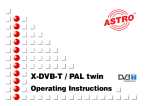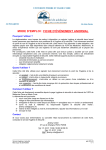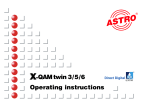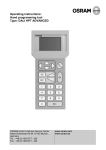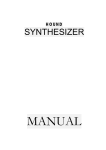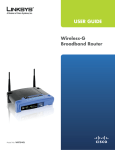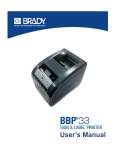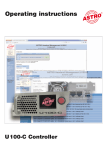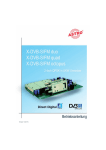Download BA X-DVBS/PAL-twin engl
Transcript
X-DVB-S / PAL twin Operating instructions Picture Content Content . . . . . . . . . . . . . . . . . . . . . . . . . . . . . . . . Page 3 Description . . . . . . . . . . . . . . . . . . . . . . . . . . . . . . . . Page 4 Installation of X-DVB-S / PAL twin card . . . . . . . . . Page 4 2.1 Installation in X-5 twin . . . . . . . . . . . . . . . . . . . . Page 4 2.2 Cabling of X-DVB-S/PAL twin . . . . . . . . . . . . . . Page 5 2.3 Changing the Audio channels (left / right) . . . . Page 5 Programming with the HE-Programming software Page 6 Basics for programming with the KC 3 . . . . . . . . . . Page 10 4.1 Structure . . . . . . . . . . . . . . . . . . . . . . . . . . . . . . Page 10 4.2 Order of Programming . . . . . . . . . . . . . . . . . . . Page 11 4.3 Store . . . . . . . . . . . . . . . . . . . . . . . . . . . . . . . . Page 11 Programming with the KC 3 . . . . . . . . . . . . . . . . . . . Page 11 5.1 Choosing parameters of the base unit / slot . . . . . . . . . . . . . . . . . . . . . . . . . Page 11 5.1.1 Adjusting the bus address of the base unit . . . . . . . . . . . . . . . . . . . Page 11 5.1.2 Choosing the slot . . . . . . . . . . . . . . . . . . Page 11 5.2 Adjusting the RF-output parameters . . . . . . . . . Page 11 5.2.1 Adjusting RF-output frequency . . . . . . . . Page 11 5.2.2 Switching off the output signal . . . . . . . . Page 12 5.2.3 Error messages . . . . . . . . . . . . . . . . . . . Page 12 5.2.4 Level adjustment of X-DVB-S / PAL twin . . Page 12 5.3 Configuration of input parameters . . . . . . . . . . Page 12 5.4 Configuration of output parameters . . . . . . . . . Page 13 5.4.1 Choosing a program . . . . . . . . . . . . . . . . Page 13 5.4.2 Audio options . . . . . . . . . . . . . . . . . . . . . Page 14 5.4.3 Manual program choise . . . . . . . . . . . . . Page 14 5.4.4 Video options / test signals . . . . . . . . . . . Page 15 Short overview of programming steps . . . . . . . . Page 17 Technical Data . . . . . . . . . . . . . . . . . . . . . . . . . . . . . . Page 18 Notes . . . . . . . . . . . . . . . . . . . . . . . . . . . . . . . . Page 19 Pictographs 1 2 3 4 5 X-DVB-S / PAL twin - Card 6 7 2 Pictographs Pictographs Italiano: Gli apparecchi elettronici non vanno smaltiti nei rifi uti urbani, bensi smaltiti in maniera appropriate conformemente alla direttiva 2002/96/CE DEL PARLAMENTO E CONSIGLIO EUROPEO del 27 gennaio 2003 su apparecchiature elettriche ed elettroniche. Quando l`apparecchio non serve piú, si raccomanda di recarlo ad un centro di raccolta pubblico previsto per lo smaltimento. Pictographs and safety information Pictographs are icons with specific meanings. The following pictographs are used in the installation and operating instructions: Warns about situations in which there is danger of lethal injury due to hazardous electrical voltage and non-compliance with these instructions. Español: Los equipos electrónicos no son basura especial, según la directive 2002/96/CE DEL PARLAMENTO EUROPEO y DEL CONSEJO del 27 de enero de 2003 deberán eliminarse correctamente los equipos eléctricos y electrónicos antiguos. Entregue este equipo al final de su utilización, para su eliminación a los centros públicos derecogida. Recycling: All of our packaging materials (packaging, identification sheet, plastic foil and bag) are fully recyclable. English: Electronic equipment is not household waste – in accordance with directive 2002/96/EC OF THE EUROPEAN PARLIAMENT AND THE COUNCIL of 27th January 2003 on used electrical and electronic equipment, it must be disposed of properly. At the end of its service life, take this unit for disposal at a relevant official collection point. Česky: Elektronické přístroje nepatří do domovního odpadu, ale musí se – dle směrnice 2002/96/EG EVROPSKĒHO PARLAMENTU A RADY z 27.ledna 2003 o elektrickych a elektronickych starych přístrojích odborně likvidovat. Odevzdejte tento příostoj na konci na jeho používání k likvidaci v komunálních sběrnych místech určenych k tomu účelu. Francaise: Les appareils électroniques doivent pas être mis dans la poubelle de la maison, mais doivent être recycles correctement selon la directive 2002/96/EG DU PARLAMENT ET DU CONSEIL EUROPEEN du 27 janvier 2003 concernant les appareils électroniques et électriques usages. Nous vous prions de metre cet appareil á la fin de son utilisation dans un emlacement prévu pour son recyclage. Türkće: Elektronik/ elektrikli cihazlar ev ćöpüne atűlmaz. Bu cihazlar AVRUPAPARLAMENTO VEKONSEYięNiN 27. Ocak 2003 tarihli 2002/96/AT Yönetmeligi uyarűnca, elektrik ve elektronik cihazlarű imha yerlerinde usulüne uygun olarak imha edilmelidir. Lütfen bu cihazű kullandűktan sonra imha edilmesi ićin öngörülen belediyeye ait toplama yerlerine teslim ediniz. Nederlands: Elektronische apparaten horen - volgens richtlijn 200296EG van het Europese Parlement d.d. 27 januari 2003 - niet thuis bij het gewone huisvuil maar moeten gescheiden ingezameld worden. Lever gebruikte elektrische en elektronische apparatuur aan het eind van hun levensduur in bij de daarvoor bedoelde verzamelpunten. 3 1 Description 1 2 Pre-configuration Description The X-DVB-S / PAL twin card is designed for the transcoding of two digital satellite TV-programmes into standard PAL-signals within the frequency range 47 – 862 MHz. It contains two independent input demodulators and one shared output converter. This means any two satellite programmes can be converted in two adjacent channels. Data Services as VPS or Teletext can be switched on and off as well as the generation of test signals. Each board has a level control for level matching of the individual plug-in boards to the same output level via KC 3 or HE-programming software. 2 Installation of X-DVB-S / PAL twin card 2.1 Installation in X-5 twin The allowed loss power of the power supply can be exceeded, if the base unit X-5 is operated with 5 cards X-DVB-S / PAL twin and the LNB remote supply is activated at the same time. To make this operation impossible, the remote supply for the LNC has to be deactivated permanently. To operate the X-DVB-S / PAL twin in the X-5 base unit, an upgrade of the X-5 main processor is necessary. Base units with this upgrade will switch off the remote supply for the LNC automatically, depending on the assembled plug-in cards. From HE programming software version 4.90, Please note: the remote supply is also switched off depending on the Authorized and qualified personnel only, is allowed to change the plug-in modules. Before this, the operating instructions, and especially the security advises, of the V16 base unit have to be read and followed. All works have to be done according to the security standards DIN VDE 0701, part 1 and 200. assembled plug-in cards. The LNC remote supply has to be realized via SSW 22 (order no.: 310 100) 4 2 Pre-configuration 2.2 Cabling of X-DVB-S/PAL twin 2 Pre-configuration 2.2 Changing the Audio Channels The X-DVB-S/PAL twin can be operated with a bridge for the input SAT-signal. This means that the SAT-IF from the loop-through output of Tuner A is bridged to the SAT-IF input of Tuner B. STANDARD Video-Jumper, don´t change! SAT-IF bridged from Tuner A to Tuner B CHANNEL A CHANGED CHANNEL B CHANGED CHANNEL A+B CHANGED Tuner A and B connected separately with SAT-IF Audio Jumper 3 Programming with HE-Programming Software 3 3 Programming with HE-Programming Software Programming with the HEProgramming Software After the installing, the X-DVB-S / PAL twin card can be programmed via HE-Programming software. If it is not possible to choose the X-DVB-S / PAL twin card from the list in the „Overview of the base unit“, you should check the settings at “Options” à “Favoured plug-in cards. The card must be activated as below, to appear on the list in the „Overview of the base unit“. In the overview of the base-unit, you can set the output channels of the X-DVB-S / PAL twin card at “RFParameters”. This means those channels, in which the, from the DVB-S bouquet selected, programs are inserted to the cable network. The chosen channel is always channel A. Channel B is automatically determined as adjacent channel of channel A. After reading out the base unit, the X-DVB-S / PAL twin card appears in the “Overview of the base unit“ on the used slot. If you now click on the “Details” button, a window opens for configuring the card details. Here you can make the relevant settings for the operation. Please Note:: Required Software version: X-5 Basis twin: 4.00 X-8 Basis twin: 1.21 V16: 1.21 Programming software 4.90 At the area „Input parameters“ you can set the input of the base unit, the symbol rate and the Viterbi rate. 6 3 Programming with HE-Programming Software 3 Programming with HE-Programming Software If you use the button “Check signal quality”, the C/N and the Bit error ratio of the input signal of the card will be displayed. You can choose the program from the transponder after a channel search, you are asked to do after programming the X-DVB-S / PAL twin card. At the area “HF-Output parameter”, the output channel can be activated and deactivated. In addition you can increase or decrease the Audio amplitude, change the Audio-Mode (Mono, Stereo…), and the TV standard (PAL or SECAM). 7 3 Programming with HE-Programming Software 3 Programming with HE-Programming Software Following to the channel search, the list with the included programs is displayed automatically. Now you can choose the program to be inserted to the cable network. gramming the card again. If you choose a multilingual program, there is the possibility to select from different Audio-PIDs. If you click on “Options” in the window of the “Parameters of the Plug-in card”, the following window appears: The program is chosen by clicking on it, without pro8 3 Programming with HE-Programming Software 3 Programming with HE-Programming Software Changes are only written and stored into the Plug-in card after clicking the button “Write Options“. The level adjustment of the X-DVB-S/PAL twin card can also be done via HE-programming software. For this you just have to click on “Level control“ in the window “Parameters of the Plug-in card”. With “Read Options”, the parameters programmed into the card will be read out and displayed. These parameters are Data Services, Test lines or manual program selection. Here you can (de-) activate data services as VPS or Teletext if provided by the transmitter and fix the CNI code hexa-decimal. Further on, there is the possibility to switch on or off test lines, and to type in the line in which the test line should be keyed in. The valid range for keying in test lines is between 17–28 and 330 and 341. If you activate the manual program selection, and you type in invalid PIDs, there is no error message in the HE-programming software! But on the television screen you can see the error message for example „NO INPUT DATA“. This is why the manual program search must be tested in the output of the head end with TV-Set or measurement equipment. But it is possible to switch off those OSD-messages by clicking on “No OSD messages” First of all you should push the button „Parameter read“, to read out the already programmed state of attenuation. The next step is the correction of the attenuation in 0,5 dB – steps. To store the changed values press „Parameter write“. 9 4 Basics for the programming with KC 3 5 Programming with KC 3 If you push the button „Restart cards“ in the window „Details of the Plug-in card“, all Plug-in cards of the base-unit will be restarted. This leads to a short-term loss of vision. This is why you have to confirm the restart. 4 Basics for the programming with the KC 3 4.1 Structure After plugging the KC 3 handheld on the base unit, the start menu appears. The software version is displayed. Please give this number to our customer service if you have questions regarding the X-DVB-S/PAL twin card. To see this menu later once again, you have to plug the KC 3 out and in again. By pressing the cursor keys ← or → you get into the menu for adjusting the parameters of the base unit, and then to the Programming of the specific parameters of the card which consists of 4 lines. You can switch between these lines with the ↑ and ↓ keys. Line 1: type of card, here X-DVB-S/PAL twin A/B Status OK Line 2: Choosing the input and (de-) activating the ON-Screen-display Line 3 / 4: RF – output parameters The programming of the parameters is made via keypad or as stepwise change of pre-defined parameters with the cursor keys ↑ or ↓. ☞ 10 Please note: Input values must be complete! 5 Programming with KC 3 4.2 Order of programming 1. 2. 3. 4. 5. 6. 4.3 5 Programming with KC 3 5.1.2 • • Choose the Plug-in card (line 1) Type in the output parameters of the Plug-in card (line 3/4) Adjust the connected TV-measurement device on the programmed output frequency Turn on the on-screen-display (line 2) Type in the input parameters in the on-screen-display Switch off the on-screen-display (line 2) 5.2 Store 5.2.1 ☞ After choosing the slot (chapter 4), the programming of the Plug-in card can begin. Choosing parameters of the base unit / slot 5.1.1 Adjusting the bus address of the base unit • Adjusting RF- output frequency Please note: The adjusting of the output frequency should always be done by choosing the channel in line 4. This makes sure that the picture carrier has a frequency according to the corresponding channel grid. Therefore the frequency in line 3 is changed automatically with the changed output channel. The output channel can be changed with the cursor keys ← or →. If you connect several base units with the ASTRO bus system, you have to make sure, that the connected base units are adjusted on different bus addresses (delivery state 241). • • Adjusting the RF-output parameters The RF-output frequency can be adjusted in line three with the input of the frequency value by keypad or in line four with the stepwise change by cursor keys ← or → (100-kHz-steps). Programming with the KC 3 5.1 Select line 1 with the cursor keys ↑ or ↓ Choose the required slot with the cursor keys ← or → By pushing the cursor keys ↑ or ↓ you get into the third or fourth line. Here you can insert the required RF-output parameters. After finishing the data input, the new parameters have to be stored by pushing the “OK/Store” button. After pushing this button, the parameters are saved. 5 Choosing the slot The input will not be checked, this means that a wrong input is stored after pushing the “OK/Store” button without warning! Select line 3 with the cursor keys ↑ or ↓ Adjust the bus address with the cursor keys ← or → in a range between 001 – 020, 241 Store changed addresses with „OK / Store“ 11 5 Programming with KC 3 5.2.2 5 Programming with KC 3 ☞ Switching off the output signal By pushing the „Menü / Read“ – button in the third line, you get to the option “Output signal On/Off”. The output signal is switched on or off with the cursor keys ← or →. Important note: You should never compensate outgoing cable attenuation by different level adjustment of the plug-in card! To do this, use the output coupler U-901 (order no.: 380 190) or VZN 8 (order no.: 380 191). To activate the changes push the „OK / Store“ button. 5.3 5.2.3 Error messages Configuration of input parameters To configure the input parameters, you have to activate the on-screen-menu first. By pushing the “Menü / Read” – button in line 2, the following picture appears on the TV set or measurement device. By pushing the „Menü / Read“ – button in the third line, you get to the display of error messages. The operational state of the plug-in card is displayed. The error message 00000010 for example stands for a missing input signal. If any other error message appears, please contact our customer service. 5.2.4 To start the configuration, select the Level adjustment of X-DVB-S/PAL twin Menu „Channel Settings“ By pushing the „Menü / Read“ – button in the third line, you get to the level adjustment of the X-DVB-S/PAL twin plug-in card. The level can be adjusted via cursor keys ← or → in a range from 0 dB up to 15,5 dB (0,5 dB – steps). All changes must be stored by pushing the “OK / Store” button. by choosing the menu „Channel Settings“ with the „OK / Store“ – button. Then you get to the main parameters of the plug-in card. 12 5 Programming with KC 3 5 Programming with KC 3 5.4 Configuration of output parameters 5.4.1 Choosing a program To change details of the output parameters, you have to choose “Select Service” in the menu “Main Parameter”. Therefore you have to choose the “Select Service” button with the cursor keys ↑ or ↓. Confirm your choice with the “OK / Store – key. The following picture appears (example): The movement between the different lines can be done with the ↑ or ↓ – keys. The parameters can be changed with the ← or → keys, or the input with the numerical keypad in the “Frequency” or “Symbolrate” option. Please note: Parameters, which are pre-defined on “auto”, should only be changed by experts. ☞ Setting the input parameters: • Type in the input frequency with the numerical keypad • Choose the SAT input • Type in the symbol rate • Choose the Viterbi ratio • Tune again 13 5 Programming with KC 3 5.4.2 5 Programming with KC 3 Audio – Options 5.4.3 Manual Program Choice If you now choose a program of the chosen bouquet, the following menu appears: If the requested station / program does not appear in the list “Select Service” you have to choose the last point “Manual PID”. Here you can choose a program manually: Here you have the possibility to change the audio language, the volume, the audio mode and the configuration of the subtitle. Any changes have to be confirmed by pressing the “OK / Store” – button. In this sub-menu, the video PID, audio PID and Teletext PID have to be entered four-digit decimal. The hexadecimal PID will be converted by the card software and displayed next to the decimal PID. If you choose a program like this and you type in wrong PIDs, there will be no error message on the OSD! This error message will be displayed in the TV-Set, for example „NO INPUT DATA“. These error messages can be faded out. For doing this, please read chapter 5.4.4. 14 5 Programming with KC 3 5.4.4 5 Programming with KC 3 Video – Options / Test signals Please choose „Options“ in the start menu. The now opened window offers the following configuration possibilities: Activating or deactivating of Teletext (if transmitted), VPS (if transmitted) and OSD error messages as well as choosing the video standard (PAL or SECAM). If you now choose the submenu „Test Pictures“ you can activate different test signals. 15 5 Programming with KC 3 5 Programming with KC 3 Several different test lines can be activated and deactivated. If you activate a test line you can choose the line for keying it in. The valid range for keying in the test line is between 17 – 28 and 330 – 341. Any changes have to be stored by choosing the “Store” button. There are two different test signals to choose: 1. black picture (choose „Black“) or 2. vertical colored beams (choose „BAR 75“) By choosing „OFF“, you see the normal program in the TV set after deactivating the OSD. ☞ The X-DVB-S/PAL twin – card offers the possibility to key in test lines. For the configuration of those test lines please choose “Test Lines” in the submenu “Options”. 16 Important note: If Teletext and test line are keyed in the same line, the test line has priority. Then the Teletext will not be fed in the network. 6 Short-overviev of programming steps Startmenü (appears only once after plugging in the KC3): ASTRO V16 Version 2,01 1 = deutsch (next < >) “ Menu / Read” → V16 Setup VMS 616 yes Power A+B Password off Choose Line 4 Password on → then “OK/Store” V16 Serie Password 0000 Password OK Menu New PW xxxx with Cursorbuttons ← or → to Menu 1 Menu 1 — Choosing the slot / channel: Choose line 1 with Cursorkeys ↑ or ↓ With Cursorkeys ← or → choose the channel V16 Parameters VMS-Input 11-14 Adress 241 Temperature 22°C 01: Slot no or unknown Plug-in Card! 04: TDVBS/P A OK Input 11 RF out 311,2 MHz Channel S 22 Menu 2 — Output parameters: Choose line 3 with Cursorkeys ↑ or ↓ 04: TDVBS/P A OK Input 11 RF out 311,2 MHz Channel S22 04: TDVBS/P A OK Input 11 RF out on with “Menu / Read” -key switch between the submenus 17 04: TDVBS/P A OK Input 11 Error 00000010 04: TDVBS/P A OK Input 11 Attenuat. -3,5 dB 7 Technical data Typ X-DVB-S/PAL twin Order no. 330 676 QPSK-Demodulator: Input Freqency range [MHz] 950–2150 Input level [dBµV] 40–80 SAT IF input [Ω] F-Jacks, 75 Return loss [dB] > =10 AFC-catch range SAT IF bandwidth Spectrum shape cos-roll-off Input data rate automatically [MHz] [%] [mBaud] Viterbi-Decodierung (acc. DVB-Standard) 36 35 2–35, adjustable 1/2; 2/3; 3/4; 5/6; 7/8, automatically/manuell HF-Modulatore Connections Output frequency [Ω] [MHz] Output channels Output level IEC-Jacks, 75 47–862 C2–C69 [dBµV] 90–100 Intermod.-distance [dB] typ. 60 Return loss [dB] > 10 Spurios frequency distance [dB] typ. 60 [dB] typ. 60 [° C] 0... +50 TV-Standard Video-signal to noise ratio B, G (D/K if requested) Common data Temp.-range 18 Notes Notes 19 82 272 452 10 / 05 ASTRO Strobel Kommunikationssysteme GmbH Olefant 1–3 D-51427 Bergisch Gladbach (Bensberg) Tel. +49 (0) 22 04 / 405-0 Fax +49 (0) 22 04 / 405 10 http://www.astro-kom.de




















